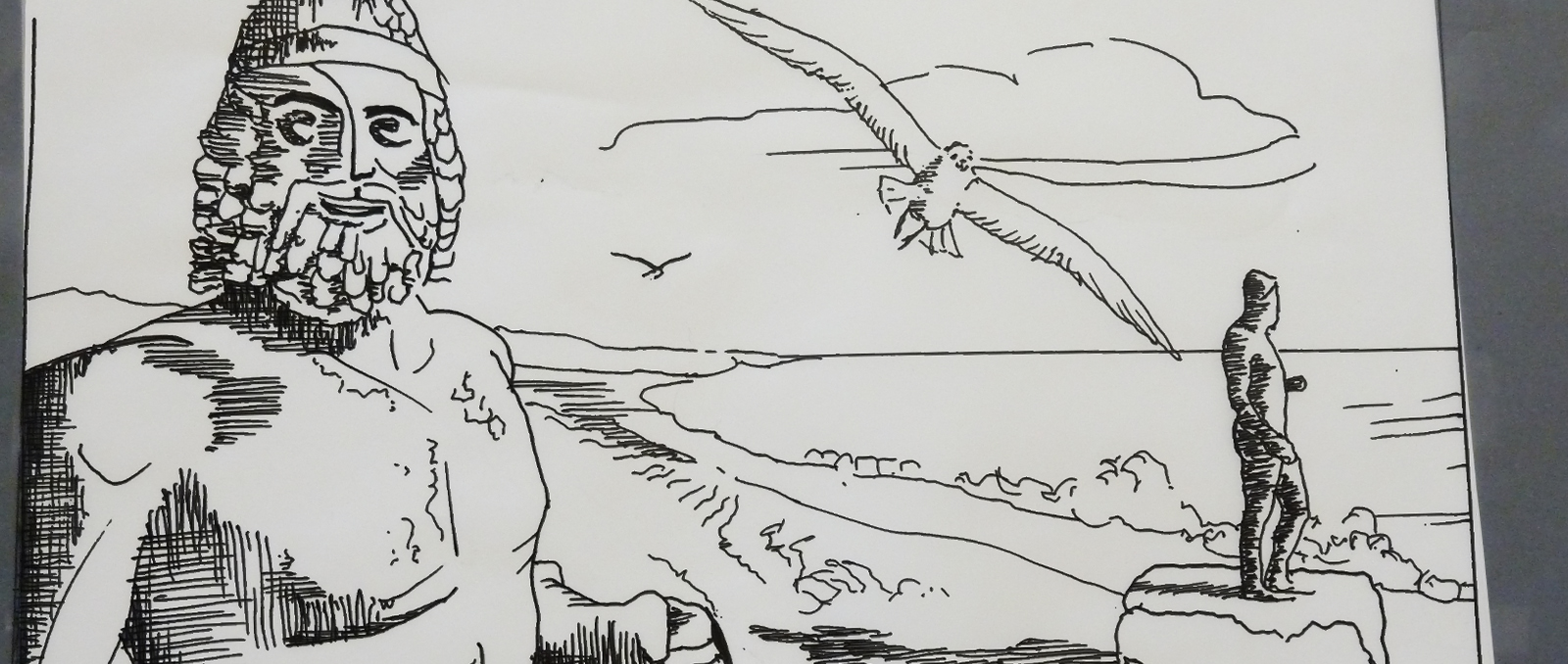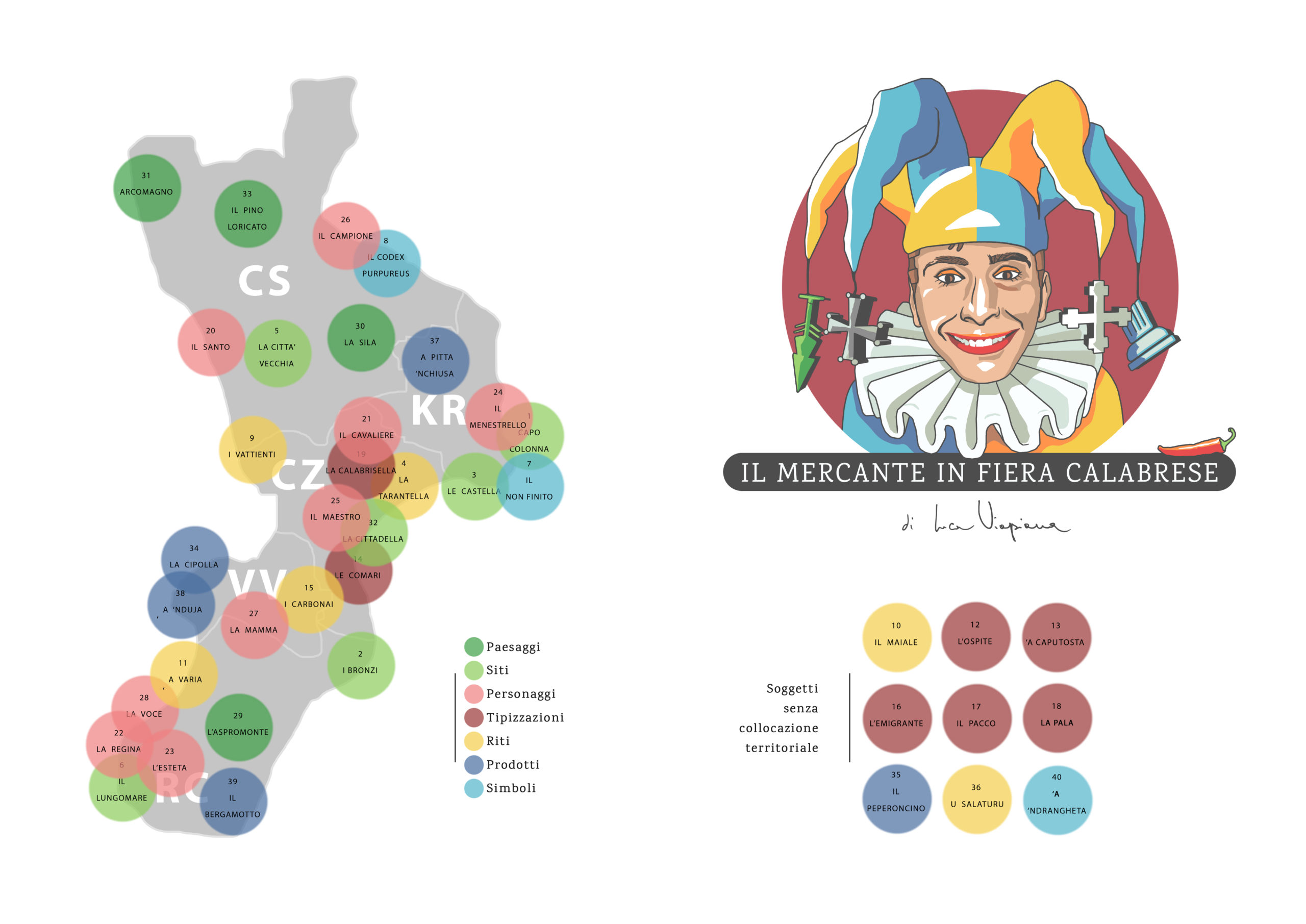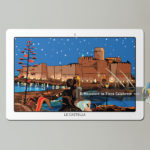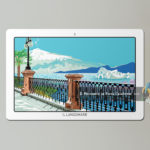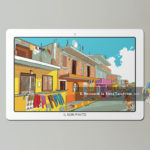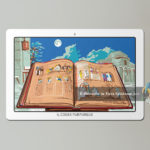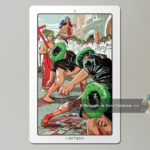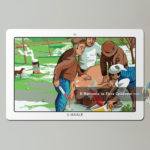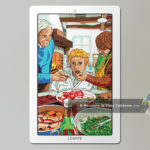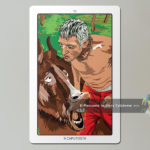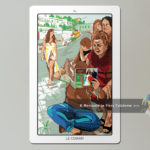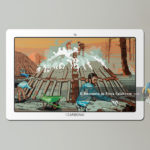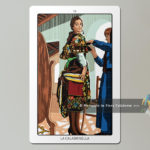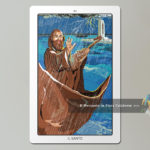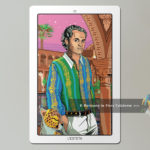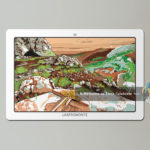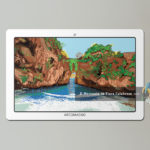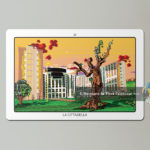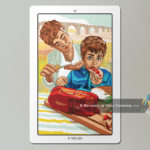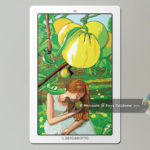With curious eyes and a dreamy soul.
Project
Paying homage to the Land of Calabria with forty heartfelt works, Luca Viapiana composes a pulsating series that, in chorus like a bunch of illustrated playing cards, explains with participation and style a splendid portion of world and people living in.
The subjects are related and integrated with each other inside an original cross-section that does not refer to a pre-packaged regional identity but documents a human heritage made of peculiarities and small gestures in which everyone can find a piece of himself and his own life experience.
The illustrations are universally usable thanks to a strong iconographic characterization that gives the images power and immediacy. Each work is accompanied by an informative text, the result of careful philological consideration.
This project, intimately linked to the culture of Calabria, was born with the purpose of discussing with those who live this land, those who do not yet know it and those who, thousands of miles away, carry in their hearts it. This joyful and coloured Calabria, full of stories and treasures, like its children scattered all over the continents wants to travel the world with curious eyes and dreamy soul.
A pulsating Calabrianity.
The drawing phase was preceded by a long phase of studies and philological analysis of the several regional areas, in order to identify those themes able to reveal a pulsating calabresity with greater intensity and clarity.
1. CAPO COLONNA (Cape Colonna)
The headland that enshrines the western edge of the Gulf of Taranto on the Calabrian side. Located a few kilometers from Crotone and formerly called Lacinion, from greek Lakistòs, literally overlooking the sea, it housed a sacred place dedicated to Hera Lacinia, lady of Olympus, protector deity of female fertility and pasture lands. In the 5th century BC, an imposing greek temple was erected inside, supported by 48 Doric columns over 8 meters high. Today only one remains, beautiful and tenacious, disarming in reminding navigators and wayfarers of the transience of all forms of devotion.
2. I BRONZI (The Bronzes)
The legendary bronze statues given to the world from the Sea of Riace (Reggio Calabria) in 1972. Dated to the 5th century BC, this dual male icon is the proof of the high sculptural mastery achieved in the classical era in Magna Graecia. The plasticity of their pose arises from the chiasm, a compositional formula that makes the flexed leg match the flexion of the opposite arm, enhancing the static balance of the figure. Harmonious and silent, exuberant but shy, although these gentle warriors are characterized by an high muscle tone, their fragile and eternal gaze refers to a metaphysical dimension.
3. LE CASTELLA (Aragonese Castle)
The thousand-and-one-nights fortress overlooking Isola Capo Rizzuto (Crotone) Bay. Nestled in the Ionian Sea, this majestic defensive monument, corsairs misfortune and merchants delight, was during millennia a hope outpost. Dated back to 400 BC, he met Magna Graecia, Turkish empire and Aragonese golden age, under which it assumed the current architectural forms. According to many researchers, the Calypso island described by Homer in the Odyssey should be placed here, in the crystal blue of these beaches, whose timeless charm lives even in the name, romantically inflected in the plural according to old-fashioned grammatical rules.
4. LA TARANTELLA (Traditional Folk Dance)
Traditional celebrating dance, the Calabrian tarantella provides Hellenic steps that make it different from other southern Italian versions, often related to exorcism practices. Inside the Rota, a circle formed by the dancers, the couples dance following the order decided by the dance master: in the mixed ones you’ll find a courtship in which the flirtatious behaviours of the woman reproduce a classic Greek style, when two men, usually coming from different villages, are the ones dancing. Then, you’ll be witness of a real duel. On the background of the illustration, the famous Catanzaro bridge, a bold concrete structure conceived in the mid-1900s by the engineer Riccardo Morandi.
5. LA CITTA’ VECCHIA (The Old Town)
The mighty walls of Cosenza vecchia, an old town wounded by abandonment but still flourishing with pride, exude poetry. Dating back to the 4th century BC, its high-quality architecture tells about the pinnacle of the Bruzia civilization, captivating travelers from all ages and backgrounds. The hill, dominated by the Suevian Castle, houses the Cathedral, defined by Unesco as Witness to a Culture of Peace, and the Rendano Theater, a 19th-century neoclassical style jewel. In 1897 the writer George Gissing, enraptured by these places, writes that at every step you can wonder and amaze. From this maze of alleys you come across convents and monuments, squares and manor houses; and in certain balconies you can still see clothes lying in the wind, traces of life like flags of resistance.
6. IL LUNGOMARE (The Seafront)
The magnificent Reggio Calabria seafront promenade is a path studded with Art Nouveau buildings, sculptures and botanical gardens praising the nickname of the Most beautiful kilometer in Italy. Often beauty sprouts up from the most severe pain, so for this great work whose development started in 1785 over an urban rebirth plan imposed by the devastating earthquake that had hit the city of the Strait. When the sky is clear, observing in the shadow of the monumental ficus trees the profile drawn on the sea by Etna, it happens, to enjoyment of the viewers, the Fata Morgana, an optical mirage granted only to the Calabrian coast showing a Sicily mirrored on the water so apparently close to be brushed.
7. IL NON FINITO (The Architectural Unfinished)
There is a perverse love binding Calabria and concrete. Unfinished building structures, for more than half a century, one of the most widespread human traces in the territory, have now historicized a real contemporary architectural style. From skeletal and partial silhouettes emerge iron pillars that draw over the sky structures that will never exist: whether they are dwellings for distant sons that will not come back home or of cumbersome and silent ruins, slags of bad politics, this building disorder, peculiar and disarming, tells and stigmatizes the unfulfilled expectations of a crowd.
8. IL CODEX PURPUREUS (Christian Manuscript)
The most important and best preserved biblical document of Christianity. Probably made in Syria around 550, this handmade masterpiece arrives fortuitously to Rossano (Cosenza) in the 8th century saved by monks fleeing Byzantium, capital of the Eastern Roman Empire where the advent of Iconoclasm had banned the cult of images. The Codex Purpureus Rossanensis is an uncial manuscript of 188 sheets of parchment dipped in the dark red of purple, a pigment granted only to the imperial family, containing gospels in Greek with 14 miniatures and gold and silver texts. Since 2015 a Unesco World Heritage Item.
9. I VATTIENTI (The Flagellants)
Every Holy Saturday throughout the districts of Nocera Terinese (Catanzaro) a century-long rite still keeps happening the rite of the Vattienti, some of the faithful in black tunic who flagellate ex voto themselves with the cardo, cork disc with 13 glass splinters, the lanze, symbolizing Christ and the apostles. The flagellants, who leave on churches and houses the rosata, an imprint of blood of good omen, are followed by the acciomu, a child dressed in red whose uncorrupted purity promises forgiveness from sin. The acrid smell of blood, mixed with that of the wine used to disinfect wounds, envelops the alleys and squares of a country crowded with believers, onlookers and anthropologists from all over Europe, attentive witnesses of a heartfelt custom, sacred and profane, still controversial and opposed.
10. IL MAIALE (The Pig)
At the beginning of the year, in the peaceful countryside preparing itself for awakening, the propitiatory and bloody ritual of the pig’s slaughtering is still taking place since immemorial time. The term seems to come from Maia, Greek and Roman goddess of agriculture to whom the pig was offered during the harvest. Across the year the beloved pig is fed with great care: that filthy beast that kicks, grunts and guzzles is a life guarranty for whole clan. Then the swine’s ungrateful fate is fulfilled and its heartrending screams are replaced by an industrious silence, respectful and strongly scented, soon supplanted, in turn, by a growing celebration noise.
11. ‘A VARIA (Religious Feast)
The Varia of Palmi (Reggio Calabria) is the feast that on the last Sunday of August celebrates Most Holy Mary of the Holy Letter, patroness of the city. For its importance in 2013 Unesco included it in the Oral and Intangible Heritage of Humanity. The Varia from which the entire festivity takes its name is a huge sacred chariot set up to symbolize universe, 16 meters high and carried on the shoulders of 200 ‘mbuttaturi. Above it, festive figures of all ages play biblical characters and angels. Among these, the auspicious Animella, an innocent winged child who, supported by the Eternal Father defies vertigo from the top of the structure to symbolize the assumption into heaven of the Virgin, returning to the heavenly home.
12. L’OSPITE (The Guest)
The proverbial Calabrian hospitality was born from thousand-year-old customs: Xenia (the Greek name) was a ritual based on mutual respect between guest and host, which stated the delivery by the latter of a parting gift that sealed the greeting. The Greeks believed that any foreigner passing through, be it a rich merchant or a beggar, could hide a disguised god intent on testing their welcoming virtues. Whoever knocks at a house in Calabria will always run the sublime risk of being overwhelmed with attention, toasts and delicious food, prepared according to tradition by vestals of the stove ready to do anything to gratify Zeus.
13. ‘A CAPUTOSTA (The Hardheaded)
The stubborn obstinacy in wanting to do things in one’s own way is a universally recognized trait of the Calabrian temperament. At times it is expressed in a stubbornness linked to a lack of mental elasticity, in others it is linked to a preconceived distrust for other people’s advice. More often, behind this rigid and apparently distrustful behaviour there is a splendid form of perseverance, virtuous and moving, carved into the DNA of a people used to struggle.
14. LE COMARI (Gossip)
Extending the meaning of baptismal godmothers, the term comari refers to those reassuring ward women, maternal and nosy, with whom one has a relationship of trust and complicity. Busy for housework or perched on a bench, in the common imagination these romantic figures love to dedicate themselves to the art of gossip. The origins of the term, from pithecus, monkey, would even delineate a curious parallelism between this morbid sharing of whispered secrets and grooming, the mutual removing of the fleas through which primates strengthen the group’s relationships. After all, the satisfaction of sharing rumours, even if such, makes a community much more stable and peaceful.
15. I CARBONAI (The Coalmen)
As guardians on the edges of steaming altars, the last coalmen, heirs to a thousand-year-old trade dating back to the Phoenicians, resist in Calabria. The term coal derives from the Greek karpho, which means to dry. In fact, the carbonization of wood involves a slow and natural combustion process whose care requires skill, dedication and a lot of effort. The woods of Serra San Bruno (Vibo Valentia) are still scattered with scarazzi, enigmatic sheaves of wood covered with wet straw and soil. This practice, characterized by customary dynamics, entailed the whole family to work in shitfs, and required 30 days of vocation and method
.
16. L’EMIGRANTE (The Emigrant)
It’s estimated that 3 million people have emigrated from Calabria, which today has 2 million inhabitants, since the unification of Italy. Argentina, Canada, Germany are just some of the attractive poles of an unprecedented exodus that has forever changed the soul of this land and has revealed new worlds to its children. The same worlds dreamed by today’s migrants, who are looking for a shore of landing and peace in Calabria. The Argentine President Macri, the Nobel Prize for medicine Dulbecco: many are the Calabrians who have honoured their roots, even masterfully, crushing racism and prejudices with tears and talent. Today as yesterday, equipped with tablets or cardboard suitcases, starving children or those fleeing from another war, all are looking for a new beginning.
17. IL PACCO (The Package)
When the pantry is empty and you can hear echoes inside the fridge, the joy given by the ringing of the bell announcing the arrival of the mythical package generates an unspeakable emotion. Students and workers away from home, far from mum and dad’s arms to find their own way, find in that cardboard box full of smells the distant flavours of home, and as if by magic, for an instant, they feel the warmth. Homemade preserves cooked by loving women, sauces sterilized under boiling, loafs of bread, soppressate and sweet surprises: anything comes out to get inside us, everything is here to talk about us.
18. LA PALA (The Wind Turbine)
The most suitable places for a wind farm are the ones open and close to the sea, so in Italy the most affected regions are in the South. The economic interests at stake are enormous and often these clean energies have been a source of dirty money for the wind lords, devoted to illicit behaviours. Every placement has a great environmental impact because the turbines are dangerous for big migrant birds, causing a barrier effect that forces cranes and storks to fly elsewhere. Beyond all that, these pinwheels stretching out to the sky, white and Gulliver-style, immaculate, are now an integral part of a landscape that has not been able to refuse them.
19. LA CALABRISELLA (The Girl from Calabria)
A character freely inspired by the figure of the pacchiana, the woman from Calabria who on feast days wears the refined ornaments of the traditional costume. In each community reveals itself in different expressions: from the scarlet tones of arbëreshë origin to the panno azzurro (blue fabric) of the southern region, passing through the monastic rigor of the ritùartu of San Giovanni in Fiore (Cosenza). Dating back to the seventeenth century, the clothes are allegories of social status because their elaborate warps represent a precise symbology in colours and cloths. The ceremonial of the first clothing, which in the illustration refers to the pacchiana from Tiriolo (Catanzaro), marks the end of childhood and the blossoming of a new calabrisella ready to find love.
20. IL SANTO (The Saint)
A character freely inspired by Francesco da Paola (1416-1507), thaumaturge saint, patron of Calabria and sea people. Called by the same name as Saint Francis from Assisi, to whom his parents had asked for the favor of having a son, when 13 years old he chose the hermit life in his beloved Cosentine moorlands, sleeping humbly on the ground with that penitential spirituality that would later lead him to give life to the Ordine dei Minimi (priestly order). As poor as to be free, he was able to free even others, defending the needs of unfortunate people from Crown and clergy. The illustration refers to the alleged miracle of the crossing of the Strait of Messina: on the way to Sicily, because of the refusal of a boatman to ferry him for free, the illuminated man sails prodigiously on the waters on board of his cloak. It’s the year 1464.
21. IL CAVALIERE (The Knight)
A character freely inspired by Mattia Preti (1613-1699), son of an respectable family from Taverna, a Silan village beside Catanzaro, is one of the greatest painters of Italian Baroque. Named Knight of Malta by Pope Urban VIII, he painted between Rome and La Valletta, merging in an original research the chiaroscuro of Caravaggio, the lights of Veronese and the gentle grace of the Guercino. But his uniqueness lies in the dynamism of the depicted characters, melodramatic actors painted while self-celebrating inside almost cinematographic staging. It’s said that the Saint Sebastian mentioned in the illustration, was rejected by the nuns who had commissioned the painting because he was too similar to the plebeian who had served as a model; the Calabrian Knight did not get perturbed and decided to exhibit it in public, so that the young painters could see a perfectly successful portrait.
22. LA REGINA (The Queen)
A character freely inspired by the singer-songwriter Loredana Bertè, born in 1964 in that Bagnara (Reggio Calabria) once known for the tireless tenacity of the women, called bagnarote, able to support the weight of the entire community by carrying on the head swordfishes, grapes and much more. Mrs. Bertè, renamed Queen of Rock for her transgressive nature and her scratchy hoarse voice, is an icon of freedom that has played a key role in the emancipation of Italian women and has never been happy with a fixed throne for venerable avant-garde. A proud and eccentric artist who has never spared anything or anyone, goody-goody people as a profession, God, her own life, and with the pathos of a Greek tragedy she brought her sleepless nights and her desperate love to the stage.
23. L’ESTETA (The Aesthete)
A character freely inspired by the fashion designer Gianni Versace (1946-1997), the visionary genius who re-wrote international fashion rules. Born after the war in a Calabria where it’s difficult even to dream, faithful to his talent, he learnt trade secrets at a very young age in his mother’s tailoring: Reggio Calabria is the kingdom where my fable life began, where I began to breathe the art of Magna Graecia. Desperately in love with beauty, Versace brought the history of Italian art on the catwalk, re-interpreting the Mediterranean Baroque with a fusion of geometries and inflorescences that freed fashion from conformism; with him models became living sculptures endowed with a new elegance because even excess, in his skilful hands, became style.
24. IL MENESTRELLO (The Minstrel)
A character freely inspired by the singer-songwriter from Crotone Rino Gaetano (1950-1981), a melancholy Gasconian who sang the love sickness with easygoing, lukewarm lyrics from the South and expressed a social criticism still current today. Irreverent and unpredictable, through moving and brilliantly nonsense ballads, he criticized and influenced italian way of life, telling a grotesque Italy suspended between political pantomime and protest. When they asked what inspired him, he defined himself as someone who stays inside coffee shops and listens the voices going around. Rino was truly that, an authentic boy seduced by world, able to fully embodying the romantic myth of the poet by vocation, that one in which art and life ever coincide.
25. IL MAESTRO (The Master)
A character freely inspired by the artist Mimmo Rotella (1918-2006), avant-garde of Nouveau Rèalisme and Pop Art. In a culturally active Catanzaro, he discovered the power of colour through the hats made by his mother, an appreciated milliner. Then, the urge to measure himself against the world and a bohemian life often experimenting, culminated i in 1953, in an epiphany that will define the theft of reality: the ripped advertising poster. Rotella rabidly steals pieces of skin from the street and gives life to the Dècollage, artworks telling cinema and economic boom in which Dadaist disorder and materic informal blend into a new and stratified language that transforms urban space into an open-air museum, ephemeral, heart breaking and very pulsating.
26. IL CAMPIONE (The Champion)
A character freely inspired by the soccer player Rino Gattuso (Corigliano Calabro, Cosenza, 1978) who in 2006, in Berlin, raised the world cup to the sky. As a boy he dreams to became, in adulthood, a fisherman: at dawn he goes fishing, at sunset he unloads cases of fish; and on the beach, in order to play football, he makes goalposts using the oil tanks of the boats. Technically little talented, it’s with his bare feet on Schiavonea Beach that he improves his skills, proving that through diligence you can go far. From the rough agonism with he fights in midfield recovering balls on balls he earns the nickname of Ringhio (Growl). A pure son of Calabria, able to redeem himself and that culture of never delegating of which he has always remained a barefoot ambassador.
27. LA MAMMA (The Mum)
A character freely inspired by the mystic from Paravati (Vibo Valentia) Fortunata Evolo (1924-2009), Mamma Natuzza, as people call her. Humble as a dirt worm, as she defined herself, she soon understood that her mission was to help needy; on the other hand, she did not immediately realize the nature of her strange abilities, of those wounds that in the days before Easter rewrote on her body the Passion of Christ. She was attributed various episodes of clairvoyance, ubiquity and diagnostic illumination. Throughout her life, every day, she disinterestedly met hundreds of people, only withdrawing when forced by health problems. A discreet and extraordinary life, studded with phenomena of which she herself seems to have been an innocent and docile instrument.
28. LA VOCE (The Voice)
A character freely inspired by the singer-songwriter and composer Mino Reitano (1944-2009), a great exponent of Italian national popular music and protagonist of an amazing career that takes him everywhere but never takes him away from his roots and those noble values that only poverty can teach. Orphaned of mother and son of a railwayman, at the age of 14 he left Fiumara (Reggio Calabria) to seek his fortune in Hamburg, a musically lively square. Here he pays his dues up to the deserved success, playing alongside legends of the calibre of the Beatles. Universally recognized for the power of his diaphragmatic singing and the proud exuberance of his performances, Mino is the voice of people, the same people who still today reciprocate the infinite love sown by him.
29. L’ASPROMONTE (Mountain System)
The inaccessible mountain system with overlapping ledges, in Reggio Calabria area, allows the coexistence of scenarios with different altitudes and atmospheres. There is something ancestral in the divine order of this massif with its mysterious caves, something liturgical in the white light that envelops its broom trees and flocks. The illustration quotes a legend dating back to the 4th century according to which Pope Sylvester, fleeing from the persecution of Christians ordered by Emperor Constantine, withdrawed from the world in a cave in Asprumunti. The emperor, struck by leprosy, wants him back in Rome to ask for his grace and after receiving it he converts himself. Before leaving for the capital, Pope hid a metal cross underground, found much later by a grazing bovine. The Sanctuary of the Virgin Mary of Polsi would rise up exactly at that point.
30. LA SILA (Mountain Plateau)
The immense mountain plateau dominating the central and northern Calabria, offering immaculate or breathtaking colours views. Formerly called Silva Brutia, it’s today divided into the sub-ranges Greek, Greater and Lesser Sila and touches the provinces of Cosenza, Crotone and Catanzaro. These enchanted places, scattered with lakes, rivers and woods worthy of a fairytale, houses an Apennine fauna of rare beauty, from the silane wolf to the eagle owl, mentioning even the very black zaccanella, a lively native squirrel with a white spot on the neck. The ground, also rich, nourishes and preserves wonders such as the Giants of Fallistro, specimens of Larch Pine 400 years old that, like living columns tending to the sky, they search for the infinite but tell history.
31. ARCOMAGNO (Beach)
In the high Tyrrhenian coast of Cosenza, in the secluded coves of the Riviera dei Cedri, you find the enchanting Arcomagno Beach. This small and magical bay, enclosed by a rocky branch giving it the appearance of a natural harbour, lies under a cliff over 100 metres high. Only the wise hand of Mother Nature, with the help of a patient erosion perpetrated by the waves, could sculpt such a marvel that, like a gate on the sea empire, invites the eye of the beholder to look for new horizons.
32. LA CITTADELLA (Regional Government Headquarters)
Like a sphinx adored by olive trees, the regional Citadel stands out against the clayish countryside of the Corace Valley (Catanzaro). Inaugurated on 2015 on a project by the architect Paolo Portoghesi, it is the administrative driving force of the regional government, it houses the Governor, the Council and 1800 employees. Renamed Palazzo degli Itali in honor of the prehistoric indigenous race from which the term Italy is thought to derive, it’s located on spaces worthy of a royal palace and 39 meters high. A strategic structure characterized by unusual volumes and elegant symmetries that well represents being the administrative core of the public affairs.
33. IL PINO LORICATO (The Loricate Pine)
In Italy Pinus leucodermis, which means white-skinned, grows exclusively in the Pollino National Park. The longest-living specimen in Europe, discovered in the core of the massif in the province of Cosenza, is 1230 years old and was baptized Italus to celebrate the king of Enotria, who lived here 3000 years ago and from which the word Italy would derive. The whipping winds and the progressive fall of the bark, whose pattern reminds the Roman military armour called lorica, make the naked trunk of the tree assume unresolved, skeletal and anthropomorphic shapes, almost as if it were a fossil with a soul. Perched on sharp rocks or scattered among the plateaus, these ivory giants defy frost and cheat on time.
34. LA CIPOLLA (The Onion)
The Red of Tropea (Vibo Valentia), the gigliaceae queen, has a thousand-year-old history dating back to the Assyrian Babylonian tradition. So called because from the postwar period onwards it was shipped all over the world from Tropea railway station, it’s cultivated along the Tyrrhenian belt, between Vibo Valentia and Cosenza, and owes its sweetness to the particularly stable microclimate in winter. Composed of concentric and fleshy white tunics, deep red and lilac, like a proletarian thousand veils deity, it has fed, supported and protected a whole rural area. No one knows the recipe of love, but for the sweetness it leaves in the mouth and for the tears it makes people shed, you would think that there is so much, so much onion inside.
35. IL PEPERONCINO (The Chili Pepper)
The fiery and mad little devil. Imported by Christopher Columbus at the end of the 15th century, the Capiscum annuum well acclimatized in the southern tip of Italy, it spread among people who could not afford fine spices and developed in different variants, from the Diavolicchio di Diamante to the Corno di Soverato, which still today color in red the gardens of Calabrians. In addition to antibiotic and preservative properties, great aphrodisiac powers are also attributed to it due to the capsaicin which it contains, burning the tongue heat receptors, gives exciting flushes of passion that, in a voluptuous and seductive poisoning, start from the mouth to reach everywhere. After all it’s something well-known, Calabrians do it pepper!
36. U SALATURU (Pickled Vegetables)
Mediterranean peoples have been using salt since the dawn of time. U salaturu, the oldest preserve and most loved by Calabrian people, is a terracotta cylinder closed by a wooden lid on which a stone is placed for 30 days, ‘a mazara, used to exert a constant pressure on that chorus of vegetables in brine that, by metonymy, will take the same name of the vessel in which they has ripened. Round peppers, olives with bones and wild fennel are just some of the ingredients of this delicacy coming from afar, whose preparation is still today a domestic ritual capable of bringing together generations far apart.
37. ‘A PITTA ‘NCHIUSA (Traditional Dry Cake)
The most typical among the Calabrian dry cakes was born in the Silan village of San Giovanni in Fiore (Cosenza) as a gift of the groom’s family during the wedding, not by chance its spiral shape symbolizes archaic wishing symbols of expansion and growth. Precisely because of the decorative aspect, for some people the name derives from the Latin picta, painted, while for others it should be associated with pitta, Greek word indicating the focaccia bread. Whatever its origins, this lovely coexistence of flour, dried fruit and honey tells the fitting fusion of many cultures that, by contaminating themselves, have given life to unique eras. Elaborate in the preparation and with refined taste, pitta ‘nchiusa, also called ‘mpigliata, is now made during Christmas and Easter period.
38. ‘A ‘NDUJA (Spreadable Pork Salami)
The hot and soft processed meat of Calabria that, spread by the exodus of its children, has seduced and conquered the globe. Humble in origins because it was originally made only from scraps, this superb mix of pork meat chopped into small pieces and chilli pepper takes its name from the French andouille, a similar sausage imported in Calabria during the Napoleonic kingdom of Gioacchino Murat and so called ’cause derivating by Latin: from inductilia, to put inside. ‘Nduja is produced mainly in the Spilinga area (Vibo Valentia), to which the great aqueduct of the Murattian period in the illustration refers.
39. IL BERGAMOTTO (The Bergamot)
The Calabrian green gold, long life elixir. This inebriating citrus fruit, whose name means pear of the Lord, from the Turkish beg armudi, is granted only in a tiny plot of land beside Locri, in the Reggio Calabria area, between Villa San Giovanni and Siderno. Characterized by an extraordinary fragrance and provided with the extraordinary property of fixing the others in time, its precious oils have been used for centuries in the cosmetic field and more recently have also shown high curative properties. Long ago the essence was isolated by hand through sponging by the mastri spiritari (alcohol masters) today the so-called Calabrian machine is used instead, the first industrial system of extraction of the precious juice, an ingenuity job that won, in 1844, the Universal Expo organized by the king of Le Due Sicilie.
40. ‘A ‘NDRANGHETA (Organised Crime)
Where a dialectic of subordination is produced between a vertex and a base there is a grey area with uncertain contours, where some people in various capacities and responsibilities collaborate in the functioning of the established powers. In the tangles of these connivances, ‘ndrangheta is often nested, the organization with a collegial summit which, through activities connected to drug trafficking, waste disposal, extortion, rigged tenders and gambling, stigmatizes the idea of Crime itself. Firmly based on the blood bond of the members of the families, the ‘ndrine, is, in fact, the only one mafia present in all five continents. Violent and alert, capable of profoundly conditioning the society since the times of the Bourbons, it steals its name from the Greek andragathía: virility, honour, rectitude.


